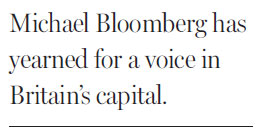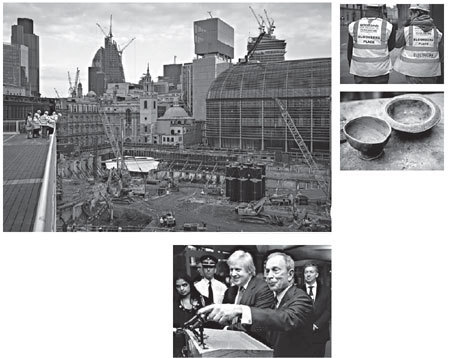New York mayor builds own British empire
Updated: 2013-03-03 08:04
By Michael M. Grynbaum(The New York Times)
|
|||||||
|
Bloomberg Place is rising in London over a temple where 2,000-year-old bowls were found. London Mayor Boris Johnson with New York Mayor Michael R. Bloomberg. Paul Hackett / Reuters Photographs by Andrew Testa for The New York Times |

LONDON - It is the biggest development in this city's buzzing financial district, and even Olympics-jaded Londoners call it grandiose: two bronze-and-stone towers, connected by sky-bridges atop the ruins of a 2,000-year-old Roman temple.
Bloomberg Place is the future European home of Michael R. Bloomberg's company and charity. But it is only one piece of the New York City mayor's growing British empire.
He is underwriting a major expansion of one of England's most prestigious galleries, in Kensington Gardens, designed by the noted architect Zaha Hadid.
He has the ear of London's mayor, Boris Johnson, who dispatches aides to City Hall in New York for tutelage in municipal management. Mayor Bloomberg and his aides court the city's elite, holding expensive dinners for tastemakers and Downing Street officials. The buzz is so great that a chief aide to Prime Minister David Cameron impishly floated the idea of a Bloomberg candidacy, for mayor of London.
As he imagines a more global life for himself after City Hall, unshackled from the nearly round-the-clock needs of running New York, Mr. Bloomberg - an Anglophile with a taste for English Regency style - is exporting his vast quantities of financial, social and political capital to this ancient city, where he has long yearned for influence.
Manhattan is home, and Bermuda a weekend escape, but no place has captured the mayor's imagination like London, a kind of Bloomberg utopia where guns are banned, drivers pay a fee at peak hours, and bicycling is a popular mode of commuting.
The affection, it turns out, is mutual: Mr. Bloomberg wrote a blurb for a book Mr. Johnson wrote.
"Mike's had a lot of cut-through in Britain," Mayor Johnson said in January. "We endlessly try to find ways of entertaining him, but generally speaking, it's the other way around."
Still, any foreign relationship has its problems. Mr. Bloomberg's attempts to install noisy air conditioners at his $20million London home have earned the ire of neighbors, prompting officials to call the plans "totally unacceptable." And some of his more high-minded policies, like limiting soda and sugary drinks sold at restaurants and movie theaters, have left residents bemused.
When the mayors met for the first time, Mr. Johnson recalled, Mr. Bloomberg kept talking about trans fats. "I didn't know what trans fats were," Mr. Johnson said. "I thought it had something to do with transsexuals, obese transsexuals, or something. Anyway, he made a great deal about that."
Just as he assiduously conquered New York's social scene, Mr. Bloomberg has, from his earliest days here, relied on parties and philanthropy to propel himself into London's upper echelon. He threw himself into the city's cultural scene, joining the boards of the Serpentine and the Old Vic theater. Even the Royal Family was in his sights. He once spent a night at Prince Charles's home in Scotland, known as Birkhall. The mayor, who keeps luxurious homes himself, later told an aide to Mr. Johnson he had been unimpressed.
Mr. Bloomberg has held parties at his two-story apartment on exclusive Cadogan Square, although his mayoralty makes it hard to spend a lot of time there. Nowadays, he often spends less than 24 hours at a time in London.
Today, Bloomberg Place is a mud pit crawling with cranes and bulldozers, but, by 2016, it will be home to a futuristic campus designed by the architect Norman Foster: it is to include a pair of undulating office buildings, pedestrian plazas, spaces for 390 bicycles, and, if the mayor gets his way, branches of New York restaurants. "It's not a timid building," Mr. Foster said from his home in Switzerland. "It will leave a large impression on London." (Some neighbors are less generous, calling it "a bulky, impenetrable mass.")
In one corner sits the Temple of Mithras, Walbrook, a relic from London's days under Roman rule. Uncovered in 1954, the temple is being restored at Mr. Bloomberg's expense. In January, archaeologists from the Museum of London turned up dozens of artifacts, including coins, pewter bowls, jewelry and a human skull. The artifacts, however, become the property of Bloomberg L.P.
Mr. Bloomberg, whose mayoralty will end on January 1, has also been dabbling in British politics. He and his company have given nearly $1.5million to English candidates and political parties. And he has spoken at gatherings of Britain's Conservative Party, whose center-right, business-friendly views he shares.
The modern London mayor's office was created in 2000. "It is very helpful for me politically in London to have such a great example of a municipal authority in New York," Mr. Johnson said.
Some Londoners, amused by his paternalistic schemes, compare Mr. Bloomberg to Titus Salt, a 19th-century English industrialist who monitored his workers' vices. (Ale consumption was strictly limited.)
"I'm not certain I would try to tell the people of London about the dimensions of their Coke portions," Mr. Johnson said.
Then he had an idea.
"We could do a swap," said Mr. Johnson, who was born in New York. "When's he standing down?"
The New York Times
(China Daily 03/03/2013 page10)
